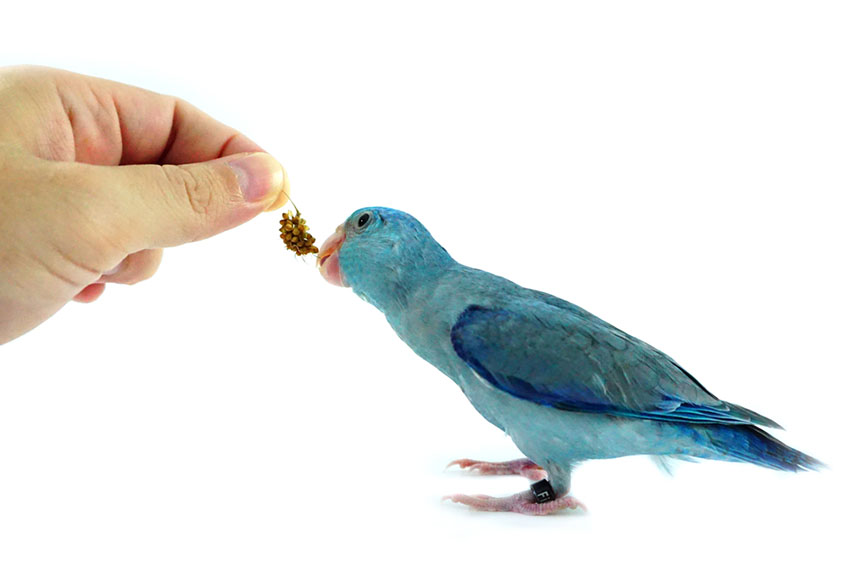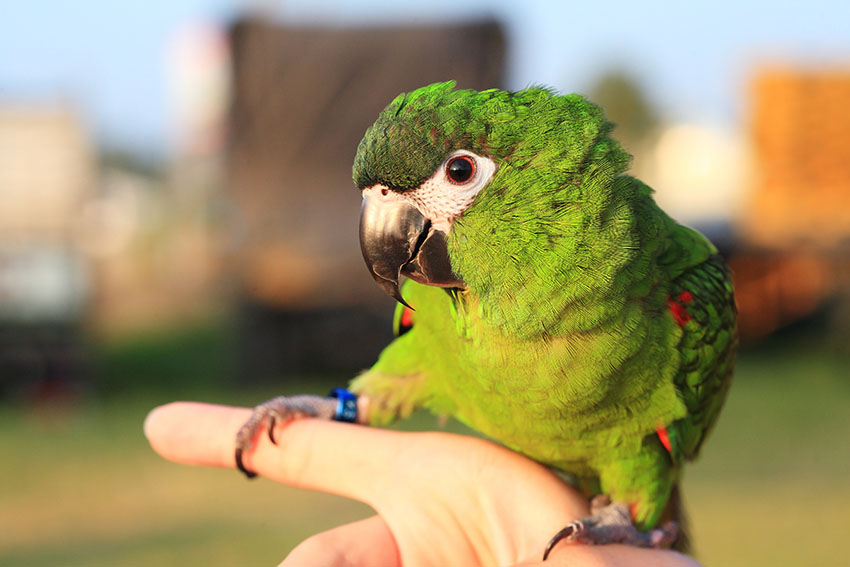- Space. The place where the training takes place needs to be a quiet spot, with minimal chance of noisy kids, dogs, etc., bursting in on the action! Even the largest and boldest parrot will become nervous and fed up with these sorts of interruption, and that could be a set-back in the training process. The obvious location to choose is the room containing the cage, as the surroundings will be familiar to the bird and it will be less likely to be distracted.
- Good mood. Training sessions work best when your pet is chilled and happy. If he’s just had a squawking fit or a panic-flap around the cage, he won’t be in the best frame of mind, and therefore won’t be able to take on board any training. First thing in the morning is an ideal time, as he parrot will be refreshed and alert but hungry after a night’s sleep. This will make the bird more eager to win the treat you will be using to reinforce his learning. If you start the training after breakfast, the parrot be less keen to earn yummy rewards.
- Training tools. Get everything ready for the training session – treats (fruit or nuts are best), a hand-held perch, and the other items mentioned below.

This Pacific Parrotlet takes his training one treat at a time!
- Parrot-proofed room. If the bird is going to be flying, the room will need to have suitable perches available. To deter the bird landing on and chewing things that shouldn’t be landed on or chewed, spray the items with bitter apple spray, either a store-bought variety or a homemade version (using 2 parts apple cider vinegar to 1 part water, in a plastic spray-mister bottle).
- Familiarity. This is key, as it’s only when the parrot is used to you and your hand that things can really begin. The bird will come to view you as a handy feeding perch. To begin with, learn how to be a perch… Offer hand-held treats by gripping them at the joint between your thumb and index finger, and extend your index finger as the perch. To encourage the parrot to hop on, rub the finger gently just above the bird’s legs.
- Time. Keep these early sessions nice and short. Most parrots get fed up after 10 or 15 minutes, so take it at the bird’s pace.
Parrot Training Methods
Shaping. “Shaping” is the parrot-training term for the reinforcement of good behavior and correct responses – not to mention the discouragement of unwanted ones. Many parrot owners use a clicker (the same as the ones used in dog training). When the parrot does what you want it to do, or has made a positive step towards it, the click and/or a treat (with an encouraging word or two) reinforces it. This helps your bird learn tricky maneuver in easy stages.
Target training. This is the basis of lots of parrot training, as it helps the parrot associate a command with an action. You can use a chopstick or a similar wooden or plastic perch. Use a command phrase such as “Come on!”, and when the parrot touches the object (with beak or feet), give your clicker a click and reward the bird with a treat. In time, the object or command phrase alone will provoke the desired response – the parrot will follow it or walk/fly to it.

This Hahn's Macaw has figured out finger-training
Step-Up. This basic technique teaches your parrot to step from one perch to another. It’s the next step up from finger-training. Grip your clicker in one hand, and offer the perch you want the parrot to step onto. Doing this is a natural instinct, so most birds step up without too much prompting. The key is to say “Step up!” as he does so – those words will, over time, become a prompt.
Click the clicker to reinforce the correct behavior. Over time, move the two perches further apart, until the parrot has to walk, hop, or fly in order to get to the second perching spot. If the bird seems reluctant, employ the “shaping” method described above (e.g. in this instance, if the bird taps the second perch with his beak, that counts as a step in the right direction and should be rewarded).
If all this has gone well, you now have a bird who is relaxed in your company, happily uses you as a perch, and will ‘step up’ from one place to another on command.
Comments
Barb, 4 February 2019
We got our Macau very young and hand fed him. Still having problems with biting. I can use some suggestions on that issue! I taught him a few games which he learned easily. His favorite is cops and robbers. He puts both wings fully up after searching for treat to steal. Stick em Up. Also rides bicycle. Need help to stop biting? He also talks but only when he feels like it.